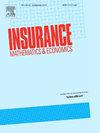Forecasting age distribution of deaths: Cumulative distribution function transformation
IF 2.2
2区 经济学
Q2 ECONOMICS
引用次数: 0
Abstract
Like density functions, period life-table death counts are nonnegative and have a constrained integral, and thus live in a constrained nonlinear space. Implementing established modelling and forecasting methods without obeying these constraints can be problematic for such nonlinear data. We introduce cumulative distribution function transformation to forecast the life-table death counts. Using the Japanese life-table death counts obtained from the Japanese Mortality Database (2024), we evaluate the point and interval forecast accuracies of the proposed approach, which compares favourably to an existing compositional data analytic approach. The improved forecast accuracy of life-table death counts is of great interest to demographers for estimating age-specific survival probabilities and life expectancy and actuaries for determining temporary annuity prices for different ages and maturities.
预测死亡年龄分布:累积分布函数变换
与密度函数一样,周期生命表死亡计数是非负的,并且具有约束积分,因此存在于约束的非线性空间中。对于这样的非线性数据,在不遵守这些约束的情况下实施既定的建模和预测方法可能会有问题。我们引入累积分布函数变换来预测生命表死亡人数。使用从日本死亡率数据库(2024)获得的日本生命表死亡计数,我们评估了所提出方法的点和区间预测精度,该方法与现有的成分数据分析方法相比具有优势。提高生命表死亡计数的预测准确性对人口统计学家估计特定年龄的生存概率和预期寿命以及精算师确定不同年龄和期限的临时年金价格具有极大的兴趣。
本文章由计算机程序翻译,如有差异,请以英文原文为准。
求助全文
约1分钟内获得全文
求助全文
来源期刊

Insurance Mathematics & Economics
管理科学-数学跨学科应用
CiteScore
3.40
自引率
15.80%
发文量
90
审稿时长
17.3 weeks
期刊介绍:
Insurance: Mathematics and Economics publishes leading research spanning all fields of actuarial science research. It appears six times per year and is the largest journal in actuarial science research around the world.
Insurance: Mathematics and Economics is an international academic journal that aims to strengthen the communication between individuals and groups who develop and apply research results in actuarial science. The journal feels a particular obligation to facilitate closer cooperation between those who conduct research in insurance mathematics and quantitative insurance economics, and practicing actuaries who are interested in the implementation of the results. To this purpose, Insurance: Mathematics and Economics publishes high-quality articles of broad international interest, concerned with either the theory of insurance mathematics and quantitative insurance economics or the inventive application of it, including empirical or experimental results. Articles that combine several of these aspects are particularly considered.
 求助内容:
求助内容: 应助结果提醒方式:
应助结果提醒方式:


